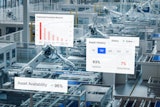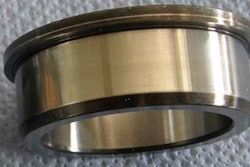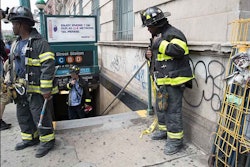Replacing your facility’s commercial roofing system is an expensive proposition, but proper planning and maintenance can make it manageable. Catching problems early can save facility owners from long-term, expensive problems. Educating yourself on the factors that damage roofs pays off.
Summer Heat
The top threat to roofing systems during the summer is extreme heat. The cycle of expansion and contraction stresses fasteners and seams. The heat also dries out the asphalt that provides the waterproofing for your roof.
Over time, UV radiation reduces a roof’s ability to maintain a waterproof barrier. Intense summer sun can cause seams to pull apart or even crack roofing materials. By weakening protective surfacing, sun damage can allow water to seep under the roof sheathing, deteriorating sub-roofing materials and undermining the safety of the structure.
Although sun damage might not be visible immediately to an untrained eye, facility managers should look for sagging or low areas on the roof. Any section of a building’s roof that slumps can hold water, which can lead to further damage.
It can also start with a leak
Another environmental threat to commercial roofing systems is water entering the structure. Leaks are not just inconveniences, they can turn into big trouble when left untreated. By allowing moisture into the building, leaks in a commercial facility’s roof start degrading its structural integrity. Wood beams can begin to rot and crumble. Mold can infiltrate the building.
Water can also soak into insulation and other critical materials. If the insulation between the roof and the top floor ceiling become saturated, it stresses the structure. Once the area of wet roofing exceeds approximately 30 percent of the total roof area, the cost of repairing the roof begins to approach the cost of a complete tear-off and replacement.
To help prevent water damage, it is recommended to have a plumber check the roof drain lines. This should be done once every few years.
Water Stains Or Mold On Any Interior Ceiling
The presence of mold and mildew within a facility can also indicate a leak. Mold can be potentially harmful to the health of the building occupants. Mold remediation adds further expense on top of repairing the leak that caused the mold.
Loose Or Flaking Roofing Material
Finding sections of loose roofing material should be an immediate cause for concern. Strong winds can peel back sections of flaking or loose roofing material, exposing the sub-materials to the elements and contributing to structural instability. It’s important to inspect facility roofs soon after any extreme weather incidents i.e., a heat wave or the first major rain event of the season.
Other Signs Of Trouble
The best way to discover problems with your commercial roofing system is through regular visual inspections. This includes visual inspection of the interior and exterior of the building’s roof assembly. Use a flashlight to inspect any recesses around ductwork, pipes, vents or equipment to ensure water is not seeping in.
On the building’s exterior, look for:
- Vegetation in contact with the roof surface
- Nails or screws from deck backing out through membrane
- Missing screens on drains
- Loose, buckled or damaged flashing or roof membrane
- Gaps or cracks in caulking around roof penetrations (vents, antennas, skylights, HVAC units, etc.)
- Excessive accumulation of granules on roof surface or in drain/gutter
- Defective, damaged or missing caulking at masonry tilt panel joints
- Debris on roof or in drains and gutters
- Cracks, blisters, punctures, or ridging, of the roof membrane
- Cracks or discoloration of acrylic domes on skylights or smoke vents
- Cracked masonry wall caps or parapets
- Bald or bare spots on the roof where UV reflective granules are missing from the cap sheet
- Cracks at sheet metal flashing joints
- Any unsealed surface mounted termination flashings
When inspecting the interior, these are signs the roof needs maintenance:
- Cracked roof deck joists, purlins or glulam beams
- Discoloration or water staining of window frames
- Discolored or water-stained ceilings and walls
- Mold on any interior surfaces
- Raised or deteriorated areas on the walls below the roof deck
- Rust, or dark staining from rust, visible on joists or other structural components
- Water staining on roof decking or roof deck joists or deterioration of the roof deck, especially at penetrations for mechanical equipment (HVAC or swamp cooler duct drops)
Documentation
In addition to visual inspections, it is valuable to document the condition of the facility roofing system. Maintaining proper records can help track the condition of the roof and whether problems are becoming widespread. In addition to administrative information, the documentation should include records of repairs or updates, maintenance and inspection schedules, and maps of any current leaks or threats. It is also recommended that photos be taken during each roof inspection to ensure the most up-to-date record of the roofing system condition.
Warranty Concerns
Regular inspection and documentation are important from a financial liability standpoint. Commercial roofing system warranties can include language that severely limits the manufacturer’s liabilities and responsibilities. Exclusions can protect manufacturers from liability caused by abuse and lack of proper roof maintenance.
The Point Of No Return
If the roof deck is in poor condition, it might be necessary for a full roofing system tear-off so it can be repaired. The best way to proceed is to hire a professional commercial roofing system contractor to evaluate the state of the roof. The contractor can offer feasible and economical alternatives of how to proceed with any roof replacement.
Alternatives To A Tear-Off?
A full tear-off and replacement of a commercial roofing system is both time — and labor-intensive. It also involves substantial costs and disruptions to facility operations. There are alternatives if damage is caught soon enough such as installing a lightweight seamless single-ply built-up roofing system over the existing roof. This should be discussed with a professional commercial roofing contractor.
When To Plan For Re-Roofing
Most commercial roofing systems have a 10- to 20-year lifetime expectation. If improperly installed or exposed to extreme environmental conditions without inspections and maintenance, the life of the roof can be significantly shorter.
By the time roof damage becomes obvious through leaks inside the building, it’s often too late to do anything more than replace the roof. It is much less expensive to repair a commercial roof before the damage becomes visible through regular maintenance and repair.
Extending the lifespan of the roof gives property managers the time to budget for the capital expenditure of replacement. Planning for roof replacement should begin at the start of its useful life, not when it is already at its end.
Rick Cunningham, president of Highland Commercial Roofing, has decades of construction industry experience and is an industry leader in commercial roofing. Rick is a member of the Institute of Roofing, Waterproofing and Building Envelope Professionals, and the U.S. Green Building Council. His company has successfully installed more than 100 million square feet of roofing on commercial properties throughout the southwestern United States.























